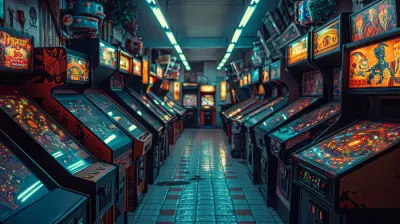How to Handle Failure in Games: Designing Death and Retry Loops
16 June 2025
Failure in games. We’ve all been there. Whether it's missing that final jump, getting crushed by a surprise boss attack, or falling off a cliff (again), failure is part of the gaming experience. But what separates a rage-quit moment from a “just one more try” loop?
That’s where smart game design comes in — specifically, how developers handle death and retry loops. It’s one of those things that, when done right, keeps players coming back for more. And when it's not? Well, cue frustration, boredom, and a hard uninstall.
So, how do you design failure in a way that feels fun and fair, not punishing and pointless? Let’s dive into it.
Why Failure Matters in Game Design
Before we talk about how to design death and retry loops, we need to talk about why failure even matters in games. You might think players just want to win — but that’s not entirely true.The real magic happens in the struggle. The challenge. The payoff of overcoming something hard-fought feels so much sweeter because you tasted a bit of defeat first.
Think of failure as seasoning in a dish. Too little, and it’s bland. Too much, and it’s inedible. The trick is getting that perfect balance.
Death Isn’t the End — It’s a Tool
Let’s bust a myth: death in games doesn’t have to be the end. It's not just a "game over" screen or a punishment for messing up.In fact, some of the best games use death as a learning moment... or even just a teaching mechanic.
Take Celeste, for instance. That precision platformer is practically designed around failure. You’ll die hundreds of times — and that’s fine! Each death is a lesson. Each retry puts you immediately back in the action, no load screens, no penalties, just another shot.
That's intentional. The game doesn’t want you to feel bad about dying. It wants you to grow.
What Makes a Good Death and Retry Loop?
1. Fast and Frictionless Restarts
Ever played a game where dying means watching a 15-second animation, listening to a character monologue, reloading from the last save, and running a mile to your objective again? Frustrating, right?Speed is king in retry loops. The quicker the restart, the more likely players are to stay engaged.
Games like Super Meat Boy nailed this. You die, and boom — you’re back in the action in a split second. No loading, no waiting. Just try again.
That kind of speed tells the player: “It’s okay, try again. You got this.”
2. Clear Feedback and Teachable Moments
If players don’t understand why they failed, they can’t learn from it. And if they feel like death was random or unfair? That’s when the controller flies across the room.Great games make it obvious what went wrong. Maybe it’s a flash of red where the enemy shot from. Maybe it’s a death animation that shows you exactly how you messed up.
The point is, make player failure a moment of clarity, not confusion.
3. Fairness Over Frustration
Failure has to feel fair. Players will accept challenging games — even brutally hard ones — if they believe it's their own fault when they die.Dark Souls is a poster child for this. It’s tough, no doubt. But when you die, it rarely feels like the game was cheating. More often, it’s you rushing, not blocking, ignoring a pattern.
The takeaway? Set rules. Stick to them. Communicate clearly. If players understand the mechanics, they’ll blame themselves — not the game — when they fail.
4. Progress That Persists
If retry loops reset absolutely everything, it can feel demotivating. Players don’t want to feel like their time was wasted.That’s why a lot of smartly designed games add slight progression even in failure.
Think about rogue-likes like Hades. You die, but you come back with a few more resources, some character insight, or maybe a new weapon unlock.
That little breadcrumb of progress makes a HUGE difference in keeping players motivated.
Different Styles of Failure Loops (And When to Use Them)
Not all death loops are created equal. Depending on your game's genre, pacing, and audience, the right retry system might look totally different.Let’s break it down.
1. Instant Retries – For Fast-Paced Games
Think arcade-style games, platformers, action-heavy stuff. The rhythm of these games is quick, so your death loops should be too.Players are in the zone. Keep them there with instant respawns and tight loop timing.
Best for: Platformers (Celeste, Super Meat Boy), twin-stick shooters (Nuclear Throne), rhythm games (Crypt of the NecroDancer)
2. Checkpoint Systems – For Story-Focused or Adventure Games
In longer, more cinematic games, you don’t want death to disrupt the immersion too much. Checkpoints let players retry from a logical moment without redoing too much.Pacing is key here. Too few checkpoints = frustration. Too many = no tension.
Best for: Action-adventures (Uncharted, The Last of Us), stealth games (Dishonored)
3. Permadeath – For High-Stakes Gameplay
Permadeath changes the whole tone of the game. It adds weight to every decision. The risk of losing everything makes victory that much more rewarding.But beware — this isn’t for everyone. It can be brutal.
Best for: Roguelikes (Dead Cells, Hades), survival games (Don't Starve), tactical games (XCOM)
4. Loop-Based Progress – For Growth Through Repetition
These games embrace death as part of the design. Each loop adds something new to the player's experience: knowledge, items, story, skills.It’s a kind of narrative treadmill — and if done well, it’s addictive in the best way.
Best for: Time-loop storytelling (Outer Wilds, Returnal, Loop Hero)
Emotional Design: Failure with Feeling
Here’s a twist: failure design isn’t just about mechanics. It’s also about emotions.If a player feels hopeless after a death, that’s a problem. But if they feel motivated, driven, even inspired? That’s powerful.
Consider how a game frames death. Is it a “You Died” in blood-red letters (Dark Souls)? A motivating “Try Again?” (Celeste)? Or maybe it’s totally baked into the narrative, like in Hades, where death is just another chapter?
Tone matters. Music, visuals, voiceover — they all shape how failure feels to the player.
Learning from Failure: What Keeps Players Hooked
The best games treat failure as a teacher, not a punishment. Let’s look at a few successful examples.Celeste: Encouragement Through Death
You’ll die a lot in Celeste. And that’s okay — the game even congratulates you for trying. Between the rapid respawns, helpful tips, and a story about perseverance, every death feels like a step forward, not a step back.Hades: Narrative Progress Through Loops
Every run in Hades ends in death — but you still gain resources, upgrade your abilities, and unlock new dialogue. It turns failure into fuel.Hollow Knight: Stakes With a Safety Net
When you die in Hollow Knight, you lose your currency... but you can go find your ghost and recover it. Risky? Sure. But it’s fair, and it gives you a second chance with tension built in.Balancing Challenge: Tuning the Difficulty Curve
Designing great failure loops also means knowing where your game sits on the difficulty spectrum.If your game’s too easy, failure never happens — and players get bored. If it’s too hard, they bounce off early.
The goal is to find that “just right” sweet spot: challenge that’s tough but conquerable.
Use difficulty ramps. Start simple, then gradually increase the stakes. Mix in a few curveballs to keep players alert, but always offer a way to recover.
Accessibility options can help here too. Let players tweak the experience based on their skill level so they stay in that challenge sweet spot.
Failure Should Be Fun… Seriously
It sounds weird, but yeah — failure can be fun if it’s done right. Think of it like learning a new trick on a skateboard. You’re gonna fall a bunch. But every fail gets you closer to nailing it.The best death and retry loops make you laugh, shake your head, and say, “Okay, one more try.”
When failure becomes part of the fun? That’s when you know your game design is working.
Final Thoughts: Turning Death into Design Gold
So let’s wrap this up.Failure isn’t something to avoid in your game — it’s something to embrace. It’s a tool. A feature. Maybe even the core mechanic.
The real skill lies in making that failure feel motivating instead of maddening. That means fast retries, fair mechanics, clear feedback, and a sense of progression even when timing is off or reflexes fail.
A well-designed death and retry loop keeps players coming back — not because they failed, but because they believe they can succeed next time.
And that belief? That’s the secret sauce.
Now go build (or play) something that makes failure feel like fun.
all images in this post were generated using AI tools
Category:
Video Game DesignAuthor:

Francesca West
Discussion
rate this article
3 comments
Alexia Brown
This article insightfully explores the balance between challenge and frustration in game design. Emphasizing thoughtful death and retry mechanics can transform failure into a rewarding learning experience for players.
June 19, 2025 at 2:27 PM

Francesca West
Thank you for your thoughtful comment! I'm glad you found the balance between challenge and frustration insightful. Transforming failure into a learning opportunity is key to enhancing player experience.
Hugo McDaniel
Thank you for this insightful article! Your tips on balancing challenge and player experience within death and retry loops are invaluable for game designers. I appreciate your thoughtful approach to failure in gaming!
June 19, 2025 at 4:25 AM

Francesca West
Thank you for your kind words! I'm glad you found the article helpful; balancing challenge and player experience is crucial in game design.
Mariana Gonzalez
In gaming's dance of rise and fall, Failures weave the bravest call. From death’s embrace, we learn to soar, Retry, evolve, and seek for more.
June 17, 2025 at 2:53 PM

Francesca West
Thank you for capturing the essence of resilience in game design! Embracing failure truly fuels creativity and innovation.



